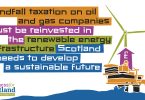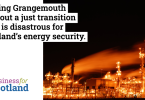
Hinkley Point has been given the go-ahead by Westminster
The UK government’s decision to go ahead with Hinkley Point has to be one of the most short-sighted, politically motivated, anti-green and even anti-Scottish energy decisions ever made by any UK government.
If you were to gather together the UK’s leading energy policy experts and challenge them to come up with an energy policy that was financially unviable, environmentally unsustainable, would guarantee household energy bills would rise for a generation and would damage Scotland’s sustainable energy future, costing jobs and economic growth, they would come up with a plan that looked just like the Hinkley Point nuclear project.
Supporters of nuclear energy will say that nuclear has low carbon emissions and they would be right, but the cost of generating nuclear energy does not include the cost of storing nuclear waste and the potential environmental damage that could cause. That cost and that problem are conveniently kicked down the road for future generations to deal with. “Don’t worry, you can hollow out a mountain and store the most dangerous radioactive waste in facilities that are supposed to last 10,000 years (twice as long as any existing building on earth).” Let’s not even bother with the issue that the waste is projected to still be fatal to humans in 250,000 years. At one conference a few years ago I heard experts suggest the plan is to hope future generations can come up with some new science to neutralise it, or will be able to afford to load it onto spaceships and fire it into the sun.
Nuclear isn’t environmentally friendly, it’s just not carbon pollution heavy, but it is operationally dangerous and environmentally reckless.
The UK government knows that Hinkley Point is a dog of a deal and it wants to cancel, but can’t. Legally the UK government is on dodgy ground trying to find a get-out clause in the agreement and, in the light of Brexit and the growing isolationist position the UK finds itself in, energy security for England is higher up the agenda. Who can say if the UK post-Brexit will be part of the planned European super-grid and what the cost of connection to it will be for a non-EU UK?

Nuclear funds could have went towards renewables R&D
Much of the research and development costs of getting nuclear to where it is today were met through military budgets, given nuclear science’s military applications. Had one tenth of the money been spent on researching renewable energy as has been spent on nuclear, it’s entirely conceivable that energy would have been almost free and 100 per cent non-carbon polluting a decade ago. Even now the money the UK government will have to spend on Hinkley is astronomical; the construction costs will be £18 billion and to encourage the French state energy company EDF to manage the project the UK government has agreed to guarantee £92.50 (2012 indexed costs) per MWh of energy produced for 35 years, which means energy produced from Hinkley Point will be at twice the current market price for energy. That’s a subsidy in the region of €110bn (£93.6bn). The contract was written five years ago when at least economic forecasts were rosier, and Brexit hadn’t added mass insecurity and damaged investment. It was a bad deal then but it’s a terrible deal now.
The Hinkley Point project has also stripped renewables funding out of the Scottish economy. Opponents of renewables argue that onshore wind is highly subsidised but clearly, investing in nuclear is far more expensive. Nuclear power generation costs have not fallen in 50 years (Hinkley Point will massively increase it) so it’s actually more expensive than subsiding renewables. Green energy costs have been reducing rapidly, with wind power costs falling 20 per cent since 2008 and solar power falling by almost 80 per cent over the same period. Solar power is becoming so widespread and cost effective that Spain is taxing not subsidising households with battery storage units, and in Australia domestic solar power generation and storage is now cheaper than buying energy from the grid.
Scotland got lucky with oil and gas but successive UK governments frittered our North Sea bonus away on debt generated outside of Scotland and failed to invest in Scotland. We have got lucky again with renewables and our biggest opportunity is the fact that with one per cent of the EU’s population we possess 25 per cent of the EU’s offshore wave and tidal energy potential. However, Westminster’s quadruple whammy of austerity, Brexit, a nuclear love affair and anti-green energy policy agenda could cost us our renewable energy future. In the 2014 referendum then UK Energy Secretary Ed Davey said: “Scotland would lose billions of pounds in subsidies for renewable energy projects if it voted for independence, putting its green energy revolution at risk.” Well guess what? That was just another broken referendum promise, as cuts to renewables subsidies have been coming through thick and fast, damaging Scotland’s target of generating 100 per cent of our energy needs from renewables by 2020. Scotland hosts some 70 per cent of UK onshore wind projects; on Sunday, August 7, we generated more than 100 per cent of Scotland’s energy needs via onshore wind – cuts to that sector’s support ending early threatens some 10,000 Scottish jobs.

Aberdeen can be converted to world centre in renewables
Tidal energy is the renewable Holy Grail for Scotland; it is reliable, predictable and will never run out. Scotland recently became the first nation to have tidal energy exported to its national grid and the world’s largest free-stream tidal power array installation has just been announced for the North Sea. Tidal is a technology in its infancy and so, yes, requires subsidy, but with every £1 from government funds pulling in £7 match funding from the private sector the 1,000 jobs being created in the sector are just the tip of the iceberg. Scotland has a once-in-a-lifetime opportunity to take a global leadership position in the development and generation of renewables. We can take the world-leading energy expertise in Aberdeen and the North East and use that as a foundation stone for converting Aberdeen into a world centre for renewables, giving Scotland a second North Sea bonanza (one we can keep) that increases over the next 40 years as the oil and gas contribution declines over the long term (current price volatility aside).
That may not suit the politics of Westminster though, as large-scale investment in Scottish renewables would lead to Scottish GDP growth. That may lead to increases in Scotland’s revenues and budget, making independence more likely. At least it would if Brexit doesn’t damage our exports and investment to the extent we miss the opportunity by virtue of still being in the UK. Another political dimension to the UK’s Hinkley Point folly?








GB, UK, whatever one terms it, is in decline as a political and constitutional construct. I say construct for a reason.
Post-imperial UK after the surrender at Singapore blew away all pretentions to power and invincibility, has struggled after a wee post war rebuild to advance an economy and infrastructure that benefits all, lays down a transport,urban and rural environment for the long term. It also has been Leone to these follies which match so-called greatness – Concorde,Trident, foreign wars and misadventures and faux propaganda from the BBC with its constant onslaught with “Great Britishisms”. These are usually mind numbing nothings about baking et al and the madness of these is shown that Lord Sugar of “You are fired” is now taking to the air ways bemoaning the fact that Channel 4 will make a hash of the new bake off!!
The Hinkley point is another milestone on the road to follies and decline. French (from the EU) and Chinese capital are needed!
Irony was never a strong point at Westminster. As the Germans now run RR cars and Bentley, iconic English marques, need one say more?
I suppose it is an example of the “broad shoulders” of the continentals and Oriental’s helping those dahn sath to fund their deficit!!
I do not normally “reply” to my article but the latest “folly” proposal appearing at a debating chamber soon is the proposal to reuse the Royal Yacht Britannia for sailing round the waves to do Brexit deals.
Symbols and faux traditions of “ruling the waves” indicates the distorted and misplaced ” values” coursing the Palace of Westminster at present.
All we need is for someone to reintroduce the royal touch to cure leprosy and illusion will reign supreme.
and let’s not forget one of the reasons the tories and labour want fracking to go ahead is because they will need somewhere to dump the waste!
dont be fooled.
why can i say this?
well anyone with a memory will remember david cameron sneaking in stealthy clauses the the change in law to prevent people from complaining about fracking happening under their own land when he added “any substance” could be left there after the wells were empty!
this means not only will the fracking poisons be left there legally, but ANY SUBSTANCE can also be put there!
YOU HAVE BEEN WARNED!
I wish those who advocate for renewable energy would stop seeing nuclear energy as the enemy and start seeing fossil-fuels as the enemy. For example, nearly all renewable enrgy has received higher strike prices than Hinkley C, as high as £305/MWh.
Those making the decision also need to take into account OECD estimates on the cost of the additional infrastructure required to integrate various low-carbon options into the grid. The OECD has estimated this to be about £2/MWh for nuclear, £20/MWh for on-shore wind, £30/MWh for off-shore wind and £50/MWh for solar.
The concern about nuclear waste might apply if we lived on a planet with very little natural radioactivity. The amount of radioactivity in nuclear waste is less than what you expect. If you bury nuclear waste below a mountain for example, the natural radioactivity of the environment ends up being 1000x the total activity in the waste. So the reason many scientists support nuclear energy is that they believe they can calculate the risk from the radiation, and it’s much less than you think.
I personally am unconvinced that 100% renewable energy is the best solution or even a solution at all. I am quite certain that there is no consensus on this issue, with large numbers of eminent scientists believing that the best solution for their children and grandchildren is to have nuclear energy as well as renewable energy in the toolkit, because the failure to address climate-change is the real environmental risk.
Just consider for a moment that there’s a 5% chance that James Hansen is correct when he says that decarbonisation without nuclear will fail. Many scientists think that it’s more like 95% likely that he’s correct, and that’s why they support nuclear energy.